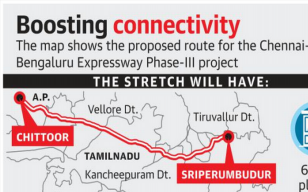Phase-III stretch falls in Andhra Pradesh and Tamil Nadu
The Expert Appraisal Committee of the Environment Ministry has recommended phase-III of the eight-lane expressway between Chennai and Bengaluru for environment clearance.
The project, implemented by the National Highways Authority of India (NHAI), passes through Chittoor district of Andhra Pradesh and Vellore, Ranipet, Kancheepuram and Tiruvallur districts of Tamil Nadu.
The stretch falls in Andhra Pradesh and Tamil Nadu. The total length of the alignment is 106.10 km, from Ramapuram in Chittoor to Irungattukottai in Sriperumbudur taluk.
Improved connectivity
The project is meant to improve connectivity between Bengaluru and Chennai and act as a link between the major commercial and industrial centres of Karnataka, Andhra Pradesh and Tamil Nadu.
The road proposed under phase-III will have 31 major bridges, 25 minor bridges, 137 culverts, 13 vehicular underpasses, 5 vehicular overpasses, 3 light vehicle underpasses, 50 pedestrian underpasses, 7 interchanges, 3 road over-bridges and 6 toll plazas. One animal underpass has also been proposed on the Forest Department’s recommendation. There is also a provision for 3 truck laybys, 4 rest areas and high mast lights.
Minimal losses
The NHAI had informed the committee that there are about 16,954 non-forest trees and 2,058 forest trees in the proposed right of way and committed itself to cutting trees within formation width so as to minimise losses.
“About 1,69,540 trees will be planted within the available space in the right of way… The balance will be planted in consultation with the Forest Department,” it had said.
The Expert Appraisal Committee laid down certain conditions for the NHAI to execute the project. It said the green belt development (tree plantation) in lieu of the trees being felled in non-forest land should be carried out by the State Forest Department as deposit work and not by a private contractor. It directed that the alignment be managed in such a manner as to save old or heritage trees.
Among other conditions, it said all the major and minor bridges and culverts should not affect the drainage systems. The floodplains of the rivers and the drainage systems should not be disturbed and efforts must be made to avoid erecting pillars on the beds of waterbodies while the over-bridges were built.
Source: Read Full Article

